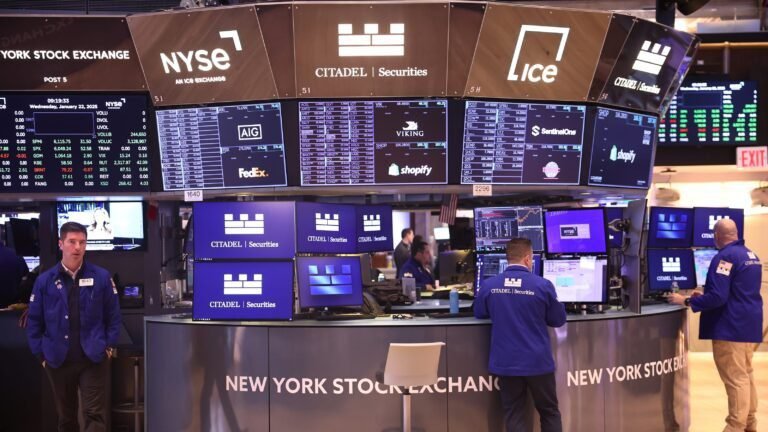Is Trump Bluffing? A Look into the President’s Tariff Threats and Their Implications
In the frenetic world of global trade, no figure has been quite as polarizing as President Trump, particularly when it comes to his fluctuating stance on tariffs. His threats have generated a cocktail of confusion and anxiety among investors, foreign leaders, and business executives alike. Are we witnessing a strategic game of poker, or is Trump genuinely looking to shake up international trade through tariffs? Let’s delve into the complexities of Trump’s tariff threats and their potential repercussions.
Trump’s Tariff Threats: The Latest Developments
As we step into the new month of February, the tension surrounding Trump’s tariff rhetoric has reached a fever pitch. The President has floated the possibility of imposing 25 percent tariffs on Canada and Mexico, alongside a staggering 60 percent levy on China—though some reports suggest it could be as low as 10 percent.
George Saravelos, a foreign-exchange analyst at Deutsche Bank, suggests it might be tempting to see these statements as mere posturing. In a recent research note, he pointed out that Trump’s inaugural address explicitly referenced tariffs not just as negotiating tools but as potential revenue boosters.
“It is tempting to see Trump’s statements as a signal that he views tariffs as a transactional tool,” said Saravelos.
A New Revenue Stream?
Is it possible that Trump sees tariffs not simply as a means to negotiate trade deals, but as a potential income generator for the government? During his inaugural address, he discussed the possibility of creating a new agency—the External Revenue Service—to help collect these tariffs. Critics, however, have raised eyebrows over how this agency would differ from the existing U.S. Customs and Border Protection. Could this be just another Trump proposition lacking a practical path forward?
- What could tariffs mean for the U.S. economy?
- Tariffs could provide a temporary boost to government revenues. However, the long-term implications could lead to:
- Accelerated inflation
- Slower economic growth
- Goldman Sachs has estimated a 70% probability that China will face new tariffs, with a 25% chance that all countries will be treated similarly.
- Tariffs could provide a temporary boost to government revenues. However, the long-term implications could lead to:
The Business Community’s Reaction: Preparation and Strategy
Among the business leaders who were initially optimistic about a Trump presidency, there’s a growing cloud of uncertainty. The World Economic Forum in Davos has transformed into an arena for speculation: just how serious is President Trump about following through with these tariffs?
Corporate Tariff War Rooms
In response to potential tariffs, companies are not waiting idly by. Many are establishing tariff war rooms to plan their strategies. These room-sized think tanks are diving into crucial questions:
- Should they pass increased costs onto consumers?
- Or should they hold prices steady in hopes of increased market share as competitors raise their prices?
Structural Adjustments
Some multinational corporations are even considering restructuring to dodge tariffs. Companies with U.S. production facilities are exploring the possibility of re-domiciling operations domestically.
A Global Game of Chess
Analysts agree that the stakes are high. Companies, especially in sensitive sectors, are aware that the upcoming tariff landscape could have ripple effects—especially if they come too suddenly or aggressively.
| Potential Tariff Impact | Immediate Effects | Long-Term Consequences |
|---|---|---|
| Price hikes for consumers | Erosion of disposable income | Reduced consumer spending |
| Weaker competitive positions | Increased cost of goods | Business closures in extreme cases |
| Inflationary pressures | Short-term gains for federal revenue | Job loss in affected industries |
The Silver Lining: Relief in the Stock Market
Despite the looming threat of tariffs, investors have managed to find some relief—S&P 500 futures saw gains following Trump’s recent hesitations. This prompts an essential question: Is his wavering stance an indication that he recognizes the potential harm of a full-blown trade war?
Tech and Finance Amidst Tariff Uncertainty
As tariff discussions swirl, other sectors are not immune to the chaos. Notably, a recent $100 billion joint venture led by Trump and tech giants like OpenAI and Oracle aims to reshape the A.I. landscape. This significant investment underlines the urgency for technological advancement, with or without tariffs clouding the economic horizon.
Conclusion: So, Is Trump Bluffing?
The current environment is a high-stakes poker game where the bluff’s outcomes can dramatically alter the landscape. With a mix of genuine strategy and calculated theatrics, Trump’s tariff threats have triggered significant reactions across various sectors.
As we move forward, one thing is clear: whether he’s bluffing or not, the ramifications of these tariff threats will resonate far beyond boardrooms, influencing consumer behavior, stock market stability, and international relations.
What are your thoughts on Trump’s tariff strategies? Do you believe they are effective negotiation tactics or merely posturing? Share your insights in the comments below and join the conversation!
















